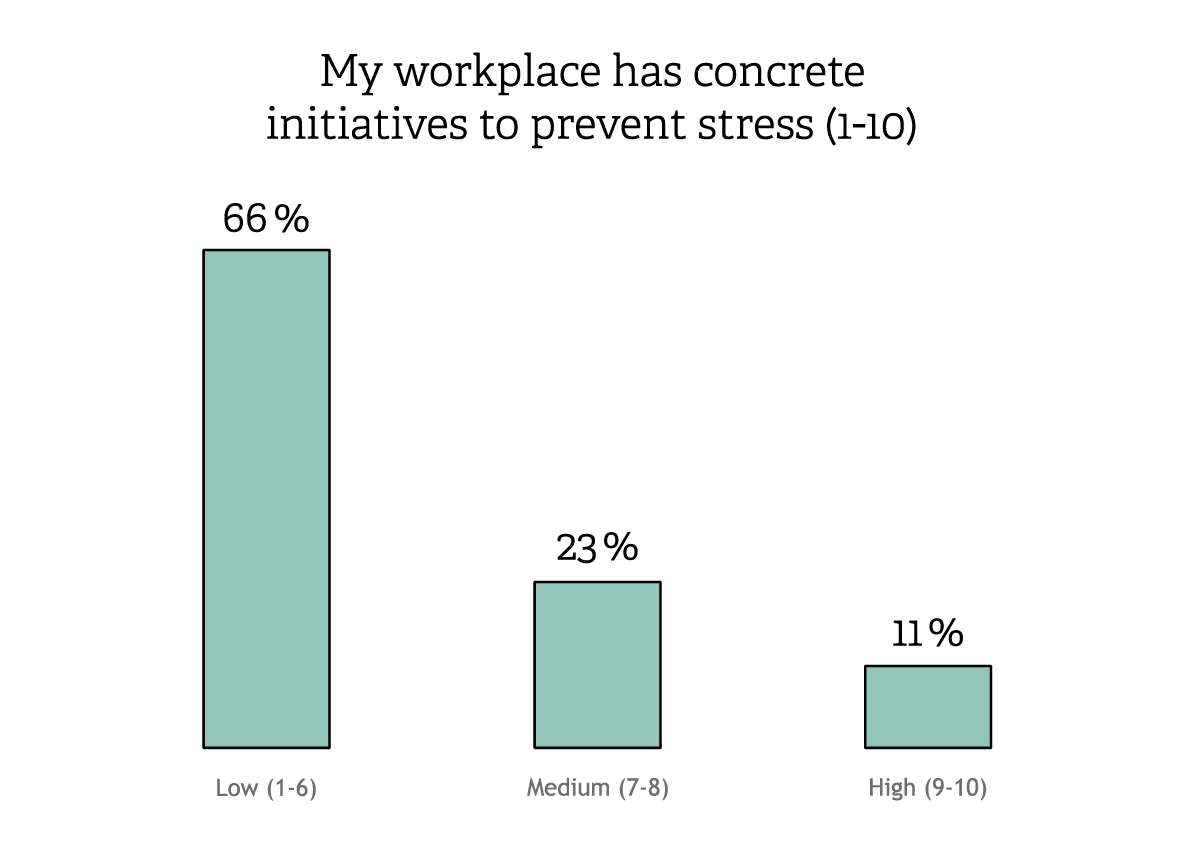Stress has become a common issue in the workplace. In our 2023 panel survey, a staggering 1 in 5 employees reported feeling stressed often or all the time, a statistic that underscores the urgency of addressing this issue. Luckily, there are a bunch of initiatives and strategies you can use to manage and reduce stress in the workplace. Let’s dive into some of them.
|
Jump to: |
Stress Management Strategies are Key – But Not Very Common
The prevailing norm in our society is that a certain level of stress is acceptable, even normal. In a work environment, this mindset overlooks the potential long-term impact on employee well-being and productivity.
According to our 2023 panel survey, only 11% of Nordic employees believe their workplace has concrete initiatives to combat stress, indicating a significant gap in stress management strategies:

Distribution of scores on the question "My workplace has concrete initiatives to prevent stress"
How Do You Manage Work Stress?
So, what can you do to meet the stress challenge? We have gathered 5 concrete actions you can take to not only manage and reduce but also prevent workplace stress:
1. Find a common language
The first step towards managing workplace stress is defining what stress means within your organization. What are its manifestations? How does it affect different roles and departments? Establishing a shared understanding is crucial to developing effective solutions.
A good place to start the work with reducing stress is therefore gathering your leaders and/or HR department and getting your definitions clear. Then you’ll have a foundation for increasing awareness and facilitating the conversation about stress amongst your employees.
2. Create a safe space for conversation
It is important that you encourage an open dialogue about stress in your organization. This begins with creating a safe space where employees can freely discuss their experiences and concerns.
There are a bunch of different approaches you can take towards eliminating the taboo about stress, such as including the topic in joint corporate meetings, or having individual conversations with your employees talking about their specific stress triggers and typical symptoms.
These approaches will not only promote a supportive environment but also help leaders and HR to identify stressed employees through their triggers and symptoms.
3. Pay attention to your employees
To prevent stress as a leader, it’s crucial that you actively engage with your team members, paying close attention to signs of stress. Regular one-on-one meetings can be an effective platform for this.
It’s also essential to balance the demands of the job with the capabilities and well-being of the individual tasked with these responsibilities.
Learn more about the nature of workplace stress and how to recognize it.
4. Use data to meet challenges early on
Incorporating data-driven approaches like surveys, conversations, and observations can provide invaluable insights into the stress dynamics within an organization.
Our panel survey showed that employees who frequently experience stress are 29% more likely to leave the company within two years compared to those who experience little or no stress, highlighting the need for proactive strategies.
A data-driven approach will help identify patterns and triggers of stress, allowing for timely interventions.
5. Be aware of the stress impact among different groups of employees
It's important to recognize that stress affects different groups in different ways. For example, in our 2023 panel survey, we found that women are more likely than men to experience stress often or all the time and that a high level of stress is more prevalent among younger employees.
There's also a clear tendency toward high levels of stress among minorities. All these disparities call for tailored approaches to managing stress in the workplace, ensuring that the strategies are inclusive and considerate of these differences.
Managing and Reducing Work Stress Comes With Multiple Benefits
Preventing and managing stress in the workplace requires a multifaceted approach. It starts with recognizing the problem, creating open channels of communication, paying close attention to the well-being of employees, and employing data-driven strategies to address stress early on.
And the effort pays off: A workplace that actively works to reduce stress is not only a healthier environment for its employees but also a more productive and stable one.
Addressing stress in the workplace is a sensitive discipline. If you are unsure where to begin, you can seek assistance from trained mental well-being experts. They can help you facilitate the conversation and create positive change toward a more balanced work environment.
References: Ennova Panel Survey 2023*
*Ennova Panel Survey 2023:
Every year, Ennova conducts external panel surveys to measure the latest trends in the workplace and to test hypotheses based on our own clients' experiences. Our Ennova Panel Survey is conducted in the Nordic countries, and the results from the survey are one of several sources we use to stay on top of the latest workplace trends.
BOOK DEMOCapture the complete employee experience
Designed to inspire and empower leaders and teams to take action and improve daily work life. Access, analyze and share your EX knowledge across your feedback programs in one place.
|

Ennova
We help organizations and leaders improve employee and customer experience with proven, concise, and engaging advisory, backed by global expertise.
More from this author


